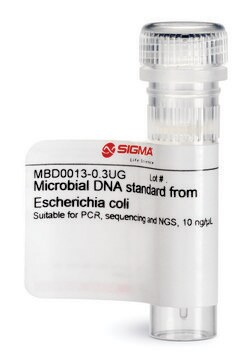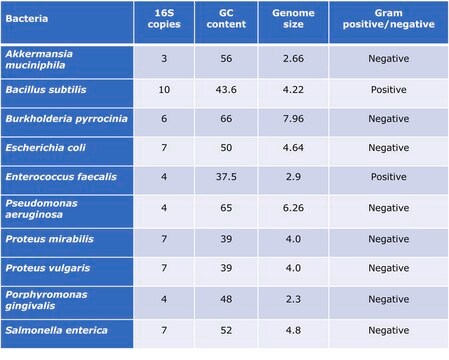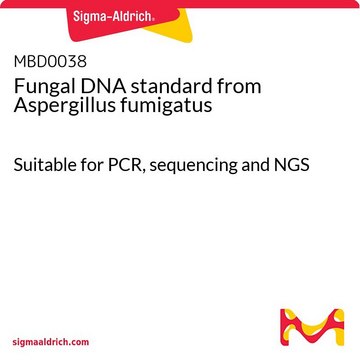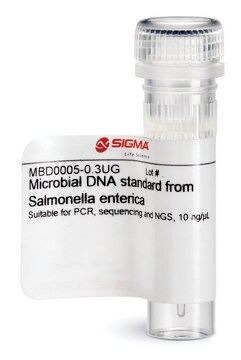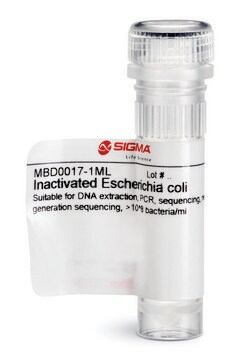MBD0044
Fungal DNA standard from Candida albicans
Suitable for PCR, sequencing and NGS, 10 ng/μL
Iniciar sesiónpara Ver la Fijación de precios por contrato y de la organización
About This Item
Código UNSPSC:
41105500
NACRES:
NA.51
Productos recomendados
Nivel de calidad
concentración
10 ng/μL
técnicas
FISH: suitable
Condiciones de envío
ambient
temp. de almacenamiento
−20°C
Descripción general
Standardization of sample analysis is essential in microbiome genomics research workflow. Lack of standardization can lead to biases and errors in common processes during sample preparation and analysis such as sample amplification, sequencing, and bioinformatics analyses.1 The human microbiome includes not only bacteria, but also viruses and fungi. While the “bacteriome” field has been researched extensively in the past years, fungi including yeasts, comprising the “mycobiome”, remain relatively neglected. Fungi and yeasts have been shown to be involved in illness conditions such as cancer and gastrointestinal disease. The human gut is populated by three fungal phyla, Ascomycota, Basidiomycota, and Zygomycota.
The fungal microbial genomic DNA standard from Candida albicans can serve as standard for benchmarking the performance along the workflow of microbiome research and metagenomic analyses, as well as a tool to increase reproducibility and allow comparison of results obtained by different labs.
Candida albicans is an opportunistic human fungal pathogen belonging to Ascomycota. It exists as a harmless commensal in the gastrointestinal and genitourinary tracts in about 70% of humans and about 75% of women suffer from Candida infection at least once in their lifetime. C. albicans has emerged as a model organism for studying fungal pathogens along with other two fungi: Aspergillus fumigatus and Cryptococcus neoformans.2
Read here how to use our standards to ensure data integrity for your microbiome research.
The fungal microbial genomic DNA standard from Candida albicans can serve as standard for benchmarking the performance along the workflow of microbiome research and metagenomic analyses, as well as a tool to increase reproducibility and allow comparison of results obtained by different labs.
Candida albicans is an opportunistic human fungal pathogen belonging to Ascomycota. It exists as a harmless commensal in the gastrointestinal and genitourinary tracts in about 70% of humans and about 75% of women suffer from Candida infection at least once in their lifetime. C. albicans has emerged as a model organism for studying fungal pathogens along with other two fungi: Aspergillus fumigatus and Cryptococcus neoformans.2
Read here how to use our standards to ensure data integrity for your microbiome research.
Aplicación
Suitable as a standard for PCR, Sanger and next generation sequencing (NGS).
Características y beneficios
- Individual microbial standard for microbiomics and meta-genomics workflow
- Suitable standard for PCR, Sanger sequencing and 18S NGS
- Improves bioinformatics analyses
- Increases reproducibility and repeatability
- Identity and purity of the genomic Candida albicans DNA has been confirmed by 18S NGS and gel electrophoresis
Forma física
Liquid -The genomic DNA is provided at ≥10 ng/μl concentration in TE buffer pH 8.0
Código de clase de almacenamiento
12 - Non Combustible Liquids
Clase de riesgo para el agua (WGK)
nwg
Certificados de análisis (COA)
Busque Certificados de análisis (COA) introduciendo el número de lote del producto. Los números de lote se encuentran en la etiqueta del producto después de las palabras «Lot» o «Batch»
¿Ya tiene este producto?
Encuentre la documentación para los productos que ha comprado recientemente en la Biblioteca de documentos.
Nuestro equipo de científicos tiene experiencia en todas las áreas de investigación: Ciencias de la vida, Ciencia de los materiales, Síntesis química, Cromatografía, Analítica y muchas otras.
Póngase en contacto con el Servicio técnico